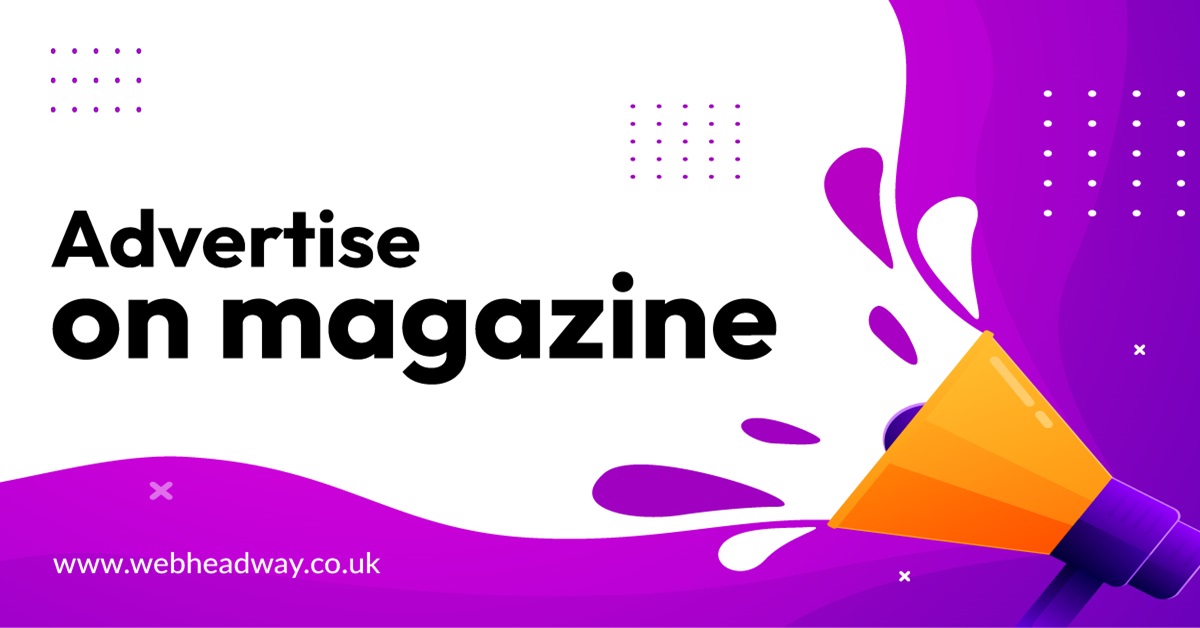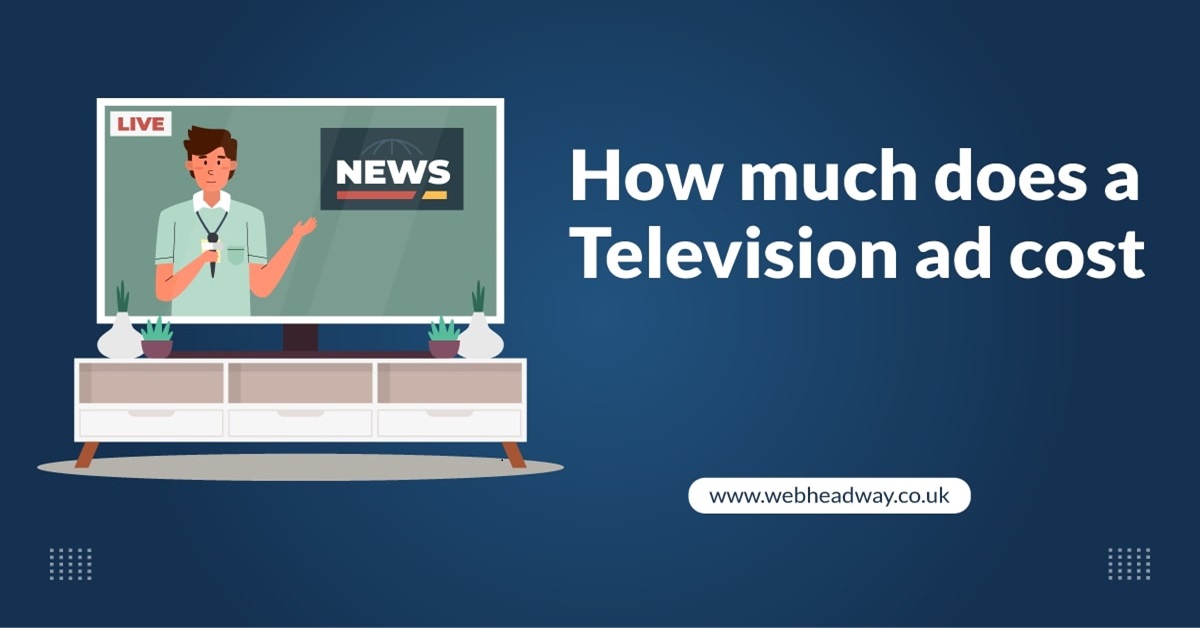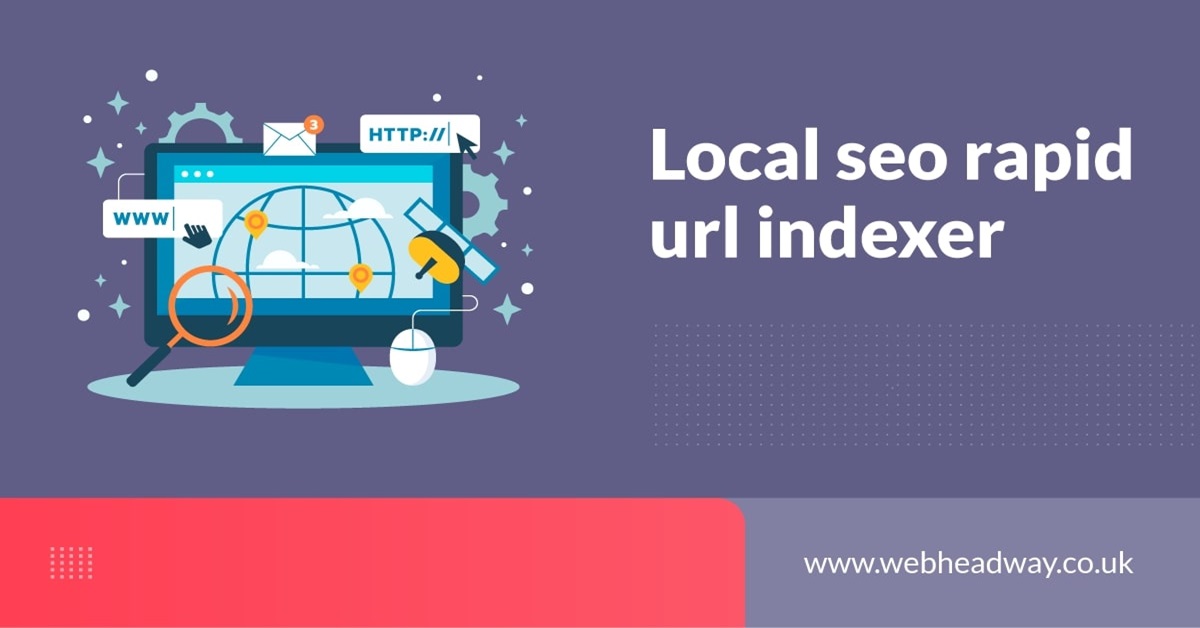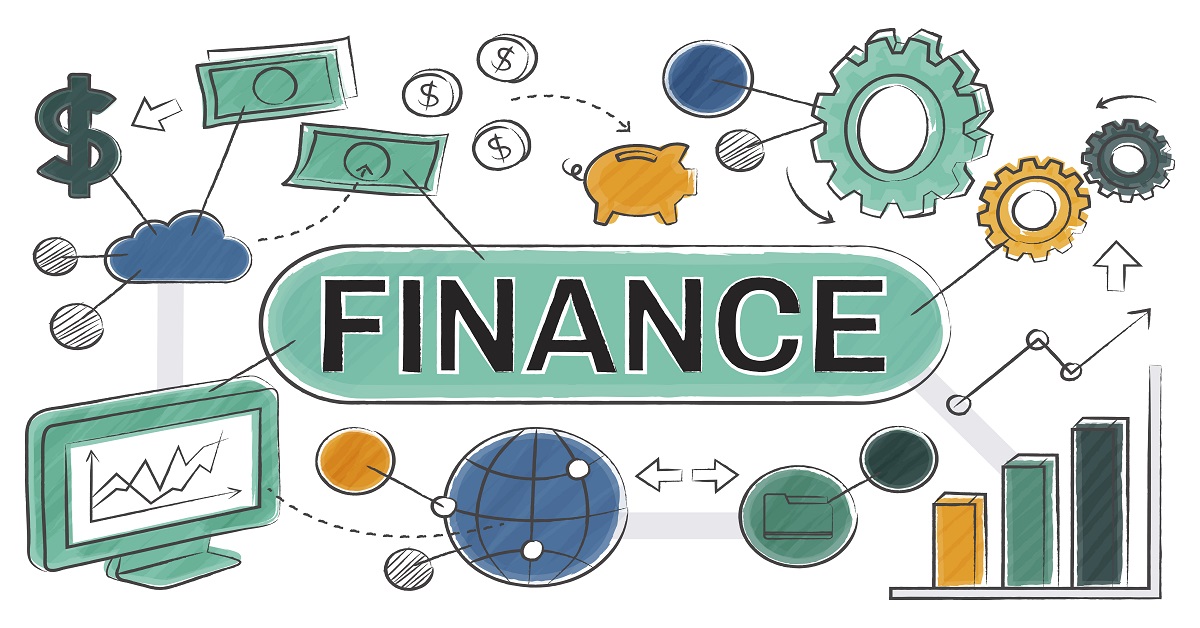Table of Contents
ToggleWhy Magazine Advertising is Important
What is Magazine Advertising?
Advertise on magazines means placing ads in print publications to promote products or services. These ads can come in different formats, like full-page ads, half-page ads, or smaller ones. Even though digital marketing has become more popular, magazine advertising is still useful for many businesses. Magazines often focus on certain topics or interests, which helps companies reach readers who are already interested in their products or services.
Why Print Advertising Still Works Today
Even with digital ads everywhere, print advertising still has some great benefits. First, printed ads give people something real to hold and see, unlike digital ads. When someone reads a magazine, they flip through pages and might find ads more meaningful than just scrolling online. Also, magazines tend to last longer since people often keep them for months and look at them again. This means ads can be seen many times.
Print advertising also lets you target smaller, specific groups. While digital ads reach lots of people quickly, magazines reach readers with certain hobbies, like fashion lovers or tech fans. This makes print ads helpful, even when digital ads are so popular.
What You’ll Learn in This Guide
In this guide, you’ll learn about different types of magazine ads and tips for making successful campaigns. We’ll also talk about measuring how well your ads work and compare magazine ads to other advertising options.
💥 Looking to mix magazine ads with an online strategy? Discover Webheadway’s Google Ads services to get the best of both worlds and grow your brand.
Benefits of Magazine Advertising
1. Reach the Right People
One of the big benefits of magazine advertising is that it helps you target the right groups. Magazines usually focus on specific readers based on things like age, interests, or job types. For example, a fashion magazine attracts people who love style, while a business magazine reaches professionals. This way, businesses can reach people who are more likely to care about their products.
2. Trust and Feel of Print Media
Print ads are seen as more trustworthy than online ads. Well-known magazines have built trust over time, and being featured in one can make your brand seem more reliable. Also, there’s something special about touching a magazine and turning its pages. It’s different from seeing an ad on a screen and helps people feel more connected. This experience is one reason why print ads still work well today.
3. Lasting Impact
Unlike digital ads that disappear after a click, magazines stick around for weeks, months, or even years. This gives your ad more chances to be seen as people read the magazine multiple times or share it with others. This longer lifespan helps your message reach more readers and makes a stronger impression.
4. Building Brand Awareness
Magazine ads can help people remember your brand. When you place ads in well-known magazines over time, it helps readers get familiar with your brand. The more often they see your ads, the more likely they are to think of your brand when they need a product like yours.
Types of Magazine Advertising
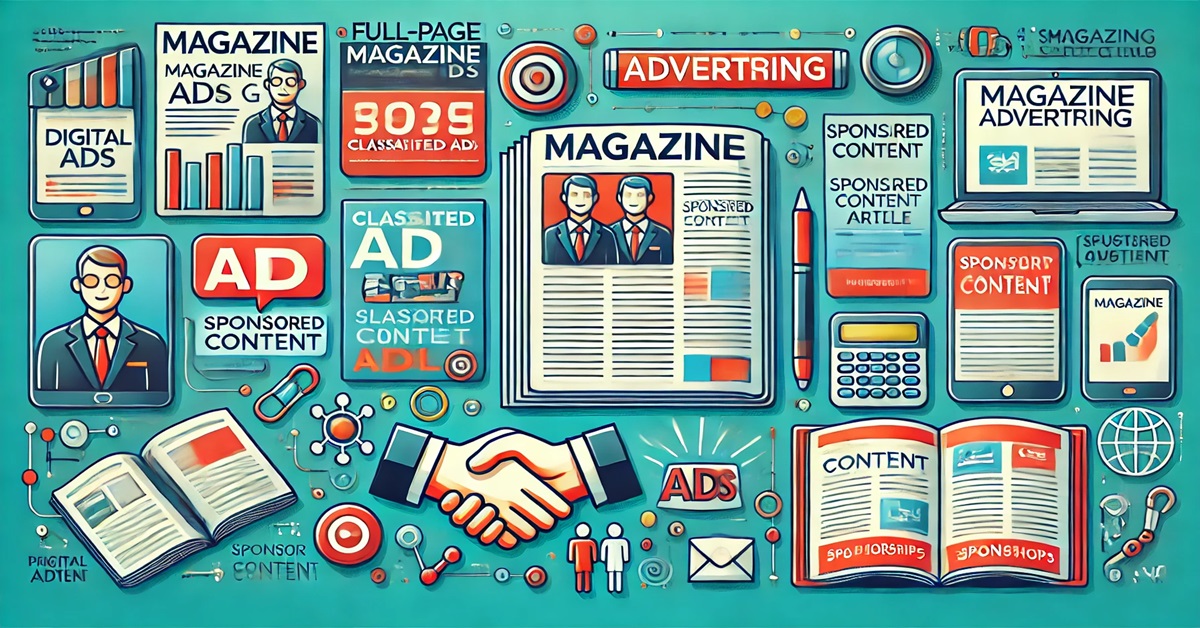
Print Advertising
- Display Ads
Display ads are the most common type of magazine advertising. They can be full-page, half-page, or even smaller. These ads use eye-catching pictures and text to attract readers. A well-made display ad can grab attention and make your brand stand out. Display ads are a big part of any magazine marketing plan because they give enough space to explain a product or show it off.
- Classified Ads
Classified ads are smaller and mostly use text. They usually go in the back of the magazine. These ads are good for special messages, like job openings or local services. Even though they’re small, classified ads are cost-effective and can reach readers who are looking for something specific.
Digital Advertising in Magazines
Many magazines now offer digital ads on their websites. These can be banners, pop-up ads, or sponsored social media posts linked to the magazine. Digital ads allow businesses to reach more people than just the magazine readers. Combining print and digital ads gives your brand more visibility.
Sponsored Content and Advertorials
Sponsored content, or advertorials, mix marketing with the magazine’s regular articles. They look like normal magazine stories but are written to promote a product in a subtle way. This type of content can engage readers while also delivering your message. Since it feels more like a story than an ad, it helps build trust.
Magazine Inserts
Magazine inserts are extras like brochures, coupons, or even samples tucked inside the magazine. These inserts give readers something to hold and use, making the ad more engaging. They are great for promoting special offers or new products.
Magazine Sponsorship Opportunities
Magazines sometimes offer sponsorship opportunities, like special issues or events. This allows businesses to connect with the magazine’s audience in other ways. By sponsoring events or features, companies can improve their magazine marketing plan and build stronger relationships with readers.
Planning Your Magazine Advertising Campaign
Setting Goals
To start a magazine advertising campaign, you need to know what you want to achieve. Do you want to get more people to know about your brand, sell a product, or get people to come to an event? Setting clear goals will help guide your choices for the ad design, placement, and budget.
Knowing Your Audience
It’s important to know who you want to reach. Find out who usually reads the magazine and see if they match the kind of customers you want. Think about their age, interests, and job types to make sure you’re reaching the right people.
Making a Budget
Magazine ads can be pricey, so it’s smart to set a budget first. Ad rates vary based on the ad size, placement, and how many people read the magazine. For example, full-page ads will usually cost more than half-page ads. Also, think about other costs like ad design or discounts for booking multiple ads.
Choosing the Right Magazine
Pick a magazine that fits your brand and audience. Don’t just look at how many people read it. Think about how engaged the readers are. Also, make sure the magazine’s content matches your brand’s style. This way, your ad will fit in better and get more attention.
💥 Want to use both print and digital strategies? Try Webheadway’s Social Media Marketing services for an integrated approach.
How to Design Great Magazine Ads
Tips for Ad Design
To make great magazine ads, keep the design simple and clear. Here’s how:
- Use Big Headlines: Catch the reader’s eye with bold headlines. Make them short but powerful.
- High-Quality Pictures: Use clear, sharp images that match your message. The pictures should help readers feel connected to the ad.
- Simple Layout: Don’t clutter the ad. Leave some empty space to make it easy to read and follow.
- Consistent Branding: Make sure to include your brand’s colours, logo, and style. This helps people remember your brand.
Picking the Right Ad Size
Magazine ads come in different sizes:
- Full-Page Ads: These have the most space for pictures and words, making them stand out the most.
- Half-Page Ads: These are less expensive but still big enough to catch attention. They can be horizontal or vertical.
- Quarter-Page Ads: These cost less and are good for local services or special deals. Even though they’re small, they can still work if the design is good.
Making a Strong Message
Your ad should have a simple, action-driven message. Focus on what your product does for the customer, and keep the wording clear. Phrases like “Limited-time offer” might help instil a sense of urgency and motivate action.
Tracking Your Ad’s Success
It’s important to know if your ad is working. Try these ideas:
- Use QR Codes or Special Codes: Add a code that readers can scan or use to get a discount.
- Unique Phone Numbers or Websites: Use a phone number or web link only shown in the ad to track responses.
- Coupons: Include a coupon that people can redeem in-store or online.
- Surveys: Ask customers how they found out about your business.
Costs and Return on Investment (ROI) for Magazine Advertising
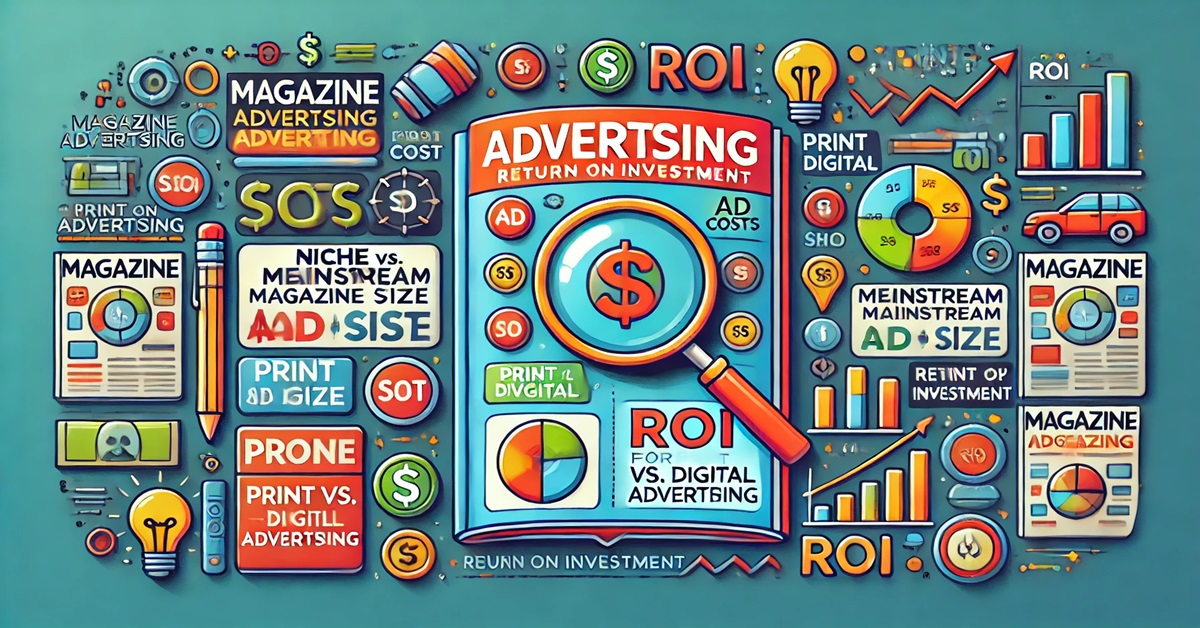
What Affects Magazine Ad Costs?
Many things can change the cost of a magazine ad:
- Size of the Ad: Bigger ads cost more. Full-page or double-page ads will be more expensive than smaller ones.
- Placement: Premium spots like the back cover cost more because they get noticed more.
- Publication Frequency: Magazines that come out often, like weekly ones, might have lower rates per issue. But you might get discounts for booking several ads.
- How Many People Read It: Magazines with lots of readers often charge more. More readers mean more exposure for your ad.
Niche vs. Mainstream Magazines
The cost of ads can also be different depending on the type of magazine:
- Niche Magazines: These focus on specific topics, so their readers are very interested in certain subjects. Even though the circulation might be smaller, the readers are more likely to care about your ad.
- Mainstream Magazines: These have larger audiences but cover a wider range of topics. They might cost more but can reach more people.
Comparing Print Ads to Digital Ads
Here’s how magazine ads compare to digital ads:
- Print Ad Costs: Print ads are usually more expensive upfront, but they stay around longer.
- Digital Ad Costs: Digital ads cost less and can be tracked easily, but they can be ignored or blocked.
- Effectiveness: Print ads feel more permanent, which can help build trust. Digital ads can reach lots of people quickly.
Measuring the ROI
Here are some ways to measure your ad’s return on investment:
- Track Sales Using Codes: Use special codes to see how many people responded to the ad.
- Count Leads: Check if you get more phone calls or website visits when the ad runs.
- Look at Sales Data: See if sales went up during the time the ad was out.
- Customer Surveys: Ask customers where they heard about you.
Picking the Right Magazine for Your Campaign
Look at the Magazine’s Readers
Make sure the magazine’s readers match the people you want to reach. Think about their age, hobbies, and interests.
Think About Circulation Numbers
Circulation numbers tell you how many copies of the magazine get out there. This can help you understand how many people might see your ad.
Check the Magazine’s Style
Make sure your ad fits in with the magazine’s style. If your ad looks like it belongs, it might get more attention.
The Value of a Loyal Reader Base
Magazines with loyal readers offer a great way to make your ad seen by the same people again and again.
Steps to Start a Magazine Advertising Campaign
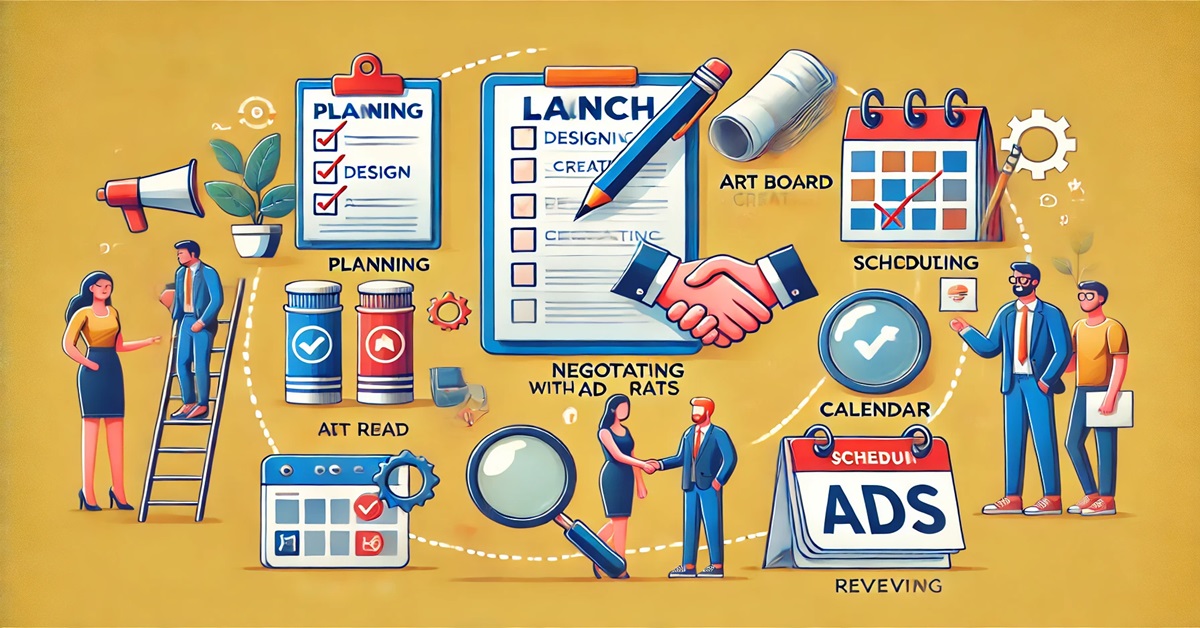
Making a Plan
Follow these steps to create your magazine ad campaign:
- Set Goals: Know what you want to achieve, like more brand awareness or product sales.
- Know Your Audience: Make sure the magazine fits the people you want to reach.
- Set a Budget: Plan how much you can spend, including ad costs and design.
- Choose the Right Magazine and Ad Size: Pick the right ad size and magazine for your goals.
- Plan When to Run the Ad: Think about important times, like holidays, to make your ad more effective.
Work with Designers
Tips for working with designers:
- Share Your Goals: Explain what you want the ad to do.
- Give a Brief: Tell the designer what you like, such as colours or styles.
- Review Drafts: Check drafts and give feedback.
- Meet Requirements: Make sure the ad follows the magazine’s rules.
Getting the Best Rates
Tips for negotiating ad prices:
- Ask About Discounts: Some magazines give discounts for multiple ads.
- Compare Different Magazines: Look at prices in different magazines to find the best deal.
- Negotiate Premium Spots: Try to get a deal on premium placements.
Decide When to Run Your Ad
Think about timing for your ad:
- Events and Seasons: Match your ad with events or seasonal trends.
- Trends in Your Industry: Advertise when interest in your topic is high.
- Product Launches: Time your ad with a new product.
Review and Adjust Your Strategy
- Check how your ad is doing and make changes if needed.
More Magazine Advertising Opportunities
Inserts and Extras
Inserts like brochures or samples can make your ad stand out and give readers something to hold.
Digital Extensions
Many magazines have online ads, like banners on their websites. This helps you reach more people.
Sponsored Editorials
These look like regular articles but promote your brand. They can feel more like a story than an ad.
Magazine Events
Some magazines hold events you can sponsor to get extra exposure.
Challenges and Solutions in Magazine Advertising
- Common Challenges
Magazine advertising can have issues like:
- High Costs: Ads can be expensive.
- Placement Problems: Getting a good spot can be hard.
- Tracking ROI: It’s harder to measure results than with digital ads.
- Standing Out: It can be tough to get noticed.
- Long Lead Times: Ads need to be planned far ahead.
- How to Solve These Challenges
- Budget Tips: Try smaller ads or look for package deals.
- Negotiate for Better Spots: Talk with the magazine about available placements.
- Use Tracking Methods: Add special codes or phone numbers to your ad.
- Create Eye-Catching Designs: Make your ad stand out with bright colours and bold text.
- Plan Ahead: Make sure you know the magazine’s deadlines.


